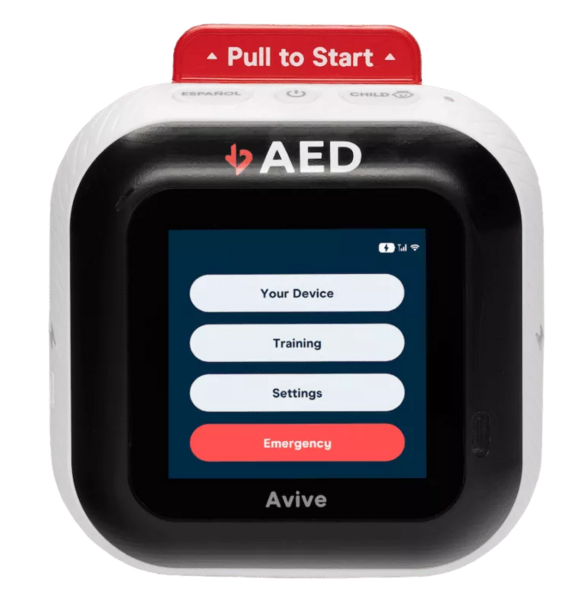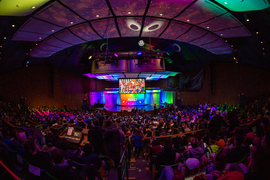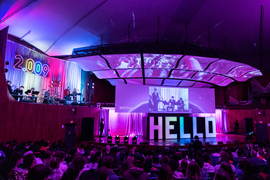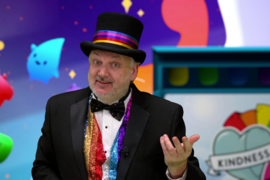On a Monday evening early each December, Kresge Auditorium transforms into something resembling a pep rally. The sold-out crowd cheers loudly, waving colorful pompoms in the air as confetti rains from the ceiling. Eight teams of MIT mechanical engineering students in Class 2.009 (Product Engineering Processes) take to the stage, demonstrating the product prototype they spent the semester working on in a presentation that would be welcome in any boardroom.
For many students, these presentations represent the finish line after months of hard work. But for others, it is when the work really begins. Over the years, dozens of 2.009 team products have inspired startups.
The curriculum of the class, which is typically taken in the fall semester of senior year, has been carefully designed to mimic the product design process at a typical product development firm. Students work on large teams of roughly 20. The class walks students through the early phases of product development — from opportunity identification to market analysis and alpha-prototype production.
Students are asked to develop a product based on a central theme that improves the quality of life for its end users. Alongside the basics of developing a business model, students receive mentorship from successful entrepreneurs and are given resources to file a patent if relevant.
“The focus in the class is to help motivate and set the foundation for students to be successful technical innovators and positive contributors throughout their entire careers, whether that be through the continuation of a product from the class, or in other pursuits,” says David Wallace, professor of mechanical engineering and longtime instructor of 2.009.
While founding companies is not necessarily the class’s intended goal, according to Wallace it is no surprise that so many startups have spun out from its projects. “This outcome is a natural extension of being immersed in a product development process focused on providing benefits to real people,” he says.
Perhaps the most useful takeaway for students interested in founding a company, according to Associate Professor Ellen Roche, is how to work on teams. “These projects provide students with an opportunity to work on larger teams, divide out roles and responsibilities, and experience team dynamics for the first time in a product development setting,” she says. This fall, Roche has served as course instructor alongside Josh Wiesman, a visiting professor of entrepreneurship from Tufts University, while Wallace has been on sabbatical.
Among the many startups that have originated in the class and continue to grow and develop toward commercialization are Encora Therapeutics, Avive, and Floe.
Encora Therapeutics: A device to relieve tremors
When Michael took to the stage in Kresge Auditorium, you could hear a pin drop. Michael, who lives with Parkinson’s disease, suffers severe tremors in his right hand. Using a marker, he traced a spiral on a piece of paper. His tremor prevented him from tracing the spiral in a clear line.
Michael then turned on a device on his wrist. With the device on, he was able to trace the spiral perfectly. The audience erupted with applause. The device Michael used was the product prototype developed by the “Purple Team” in fall 2017. Then called Animo, the wearable device used vibration therapy to reduce tremors in patients with neurological movement disorders. “When Michael traced his second spiral, the first thing I felt was relief, followed by overwhelming emotion and gratitude toward Michael and his family for trusting us and allowing us to show his Parkinson’s disease in such a public way,” says Allison Davanzo ’18, one of the Purple Team members. “Seeing their emotional response is what made me realize I wanted to bring that feeling to others like Michael around the world.”
Davanzo and some of her fellow teammates decided to explore opportunities for launching a business with their device. They utilized entrepreneurship resources at MIT like the MIT Sandbox Innovation Fund Program, the Martin Trust Center for MIT Entrepreneurship “delta v” accelerator, the MIT $100K Entrepreneurship Competition, and the PKG IDEAS Social Innovation Challenge, to a name a few.
With the help of these programs and resources, Davanzo honed the idea started in 2.009 and co-founded Encora Therapeutics with fellow Purple Team members Daniel Carballo ’18 and Kyle Pina ’18. The latest version of the device the team has built uses sensors to assess the severity of a tremor. Depending on the tremor severity, the device will tune the frequency and strength of the vibration it produces. This customized vibration stimulates nerves in the wrist. These nerves send a signal to the brain to indicate the wrist is already tremoring. As a result, the brain sends fewer tremor signals back to the wrist. The Encora team was granted an FDA Breakthrough Designation in 2021 and is planning a pivotal study before submitting for regulatory clearance to market the device to consumers.
Pina credits 2.009 for giving him, Carballo, and Davanzo the tools needed to found a startup.“2.009 taught us to how to balance the many aspects of starting a company, wearing different hats when needed. That has been a crucial skill, since not only have we dealt with product and business development, but our roles have also expanded to include regulatory and clinical studies,” says Pina.
Avive: Connecting AEDs to those who need them
After his 2.009 team presented their product Revive, a portable automated external defibrillator — or AED — that could be charged using a cell phone battery, Rory Beyer ’17 was invited to speak at the annual Parent Heart Watch Conference in January 2017. The event was dedicated to preventing cardiac arrest in youths.
Beyer did a live demo of Revive in front of an audience of several hundred people. He received a standing ovation.
“At MIT you’re in this bubble, so having validation from groups dedicated to this cause, ranging from legislators to medical professionals to parents who had lost children to cardiac arrest, was a really pivotal moment,” says Beyer.
At the conference, Beyer and his 2.009 teammate Moseley Andrews ’17 met Sameer Jafri, then a student at the University of California at Los Angeles. Together, the trio co-founded a startup, now called Avive. The company has built a user-friendly AED that is fully connected with Wi-Fi, cellular data, GPS, and Bluetooth capabilities.
When someone calls 911 to report a sudden cardiac arrest, the 911 dispatcher can launch an “Avive” button. Avive AEDs near the person experiencing the medical emergency will light up and display a map, leading a user to the patient. Additionally, any Avive app user nearby will get an alert that navigates them to the nearest Avive AED, and then to the patient. This connectivity could save countless lives.
Beyer and his co-founders plan to target customers like gyms, office buildings, and schools, some of whom are legally required to have an AED on site. They also plan to work with cities on putting enough Avive AEDs in place that a device is never more than four minutes away from a person experiencing cardiac arrest. Eventually, they hope to get their AEDs in the houses of individuals who are particularly susceptible to cardiac arrest.
Avive, which received FDA approval in October, is the first new company in 20 years to have a defibrillator approved on the market. Beyer, who serves as Avive’s chief operating officer and president, reflects on his time in 2.009 as crucial in helping them refine their product offering.
“The class gives you a structure and a framework to run a development process. And that’s invaluable when you’re starting a company that is so technology-focused, because your company is based on the product that you’re building,” he adds.
Floe: A new way to prevent ice dams
For their 2.009 project, David Dellal ’17 and his fellow Silver Team members developed a solution to address a practical problem that many home and business owners face each year: ice dams. Ice dams form when heat from a building melts snow on a roof, forming ice. The water that pools behind the ice dam can leak into a house or office, causing damage that can be catastrophic. For their project, the Silver Team designed Floe, a cost-effective, smart system that combines drip irrigation with de-icing fluids.
“Traditionally, heating cables have been used to melt ice and snow on a roof. This is actually really dangerous and expensive. So, we started to explore mechanical and chemical approaches,” says Dellal. “We had a eureka moment where we realized that we could solve the water issue by irrigating a small amount of de-icing fluid in certain locations.”
The Floe system is embedded with temperature and water sensors that sense when conditions could lead to ice dam formation. In the original design, a mixer combines de-icing fluid with a building’s water supply. The fluid then travels to tubing with drip emitters on the roof. This creates channels that drain the water behind ice dams, preventing damage.
After the final presentation in 2.009, three members of the Silver Team, including Dellal, decided to explore founding a company with Floe’s technologies. They received funding from MIT Sandbox, MIT delta v, the MIT Water Innovation Prize, and the MIT $100K Competition, as well as mentorship via MIT’s Venture Mentoring Services.
A year-and-a-half later, Dellal, who serves as Floe’s CEO, connected with his fraternity brother Hector Castillo ’20 and asked him to join the Floe team. Then a senior studying mechanical engineering, Hector was working on his own 2.009 team project at the time. According to Castillo, the experience prepared him for his current role of chief technology officer.
“One of the big things for me about 2.009 is you aren’t just working on a P-set by yourself. You have to learn how to manage a team of people and stakeholders. That’s especially important for me as CTO, since I manage the product development side of things,” Castillo adds.
In winter 2021, the Floe team conducted a pilot on roofs, including buildings in Maine, ski resorts in Colorado, and MIT’s very own Building 24. The team is in the process of finalizing product development so they can do a full-scale launch.
Castillo says the team continues to draw from their 2.009 experiences.
“The class definitely pushed me beyond hacking a project in my dorm room. It rounds out your engineering education by pulling it into the real world, where nearly all engineering projects have customer and business components to them,” he says.













